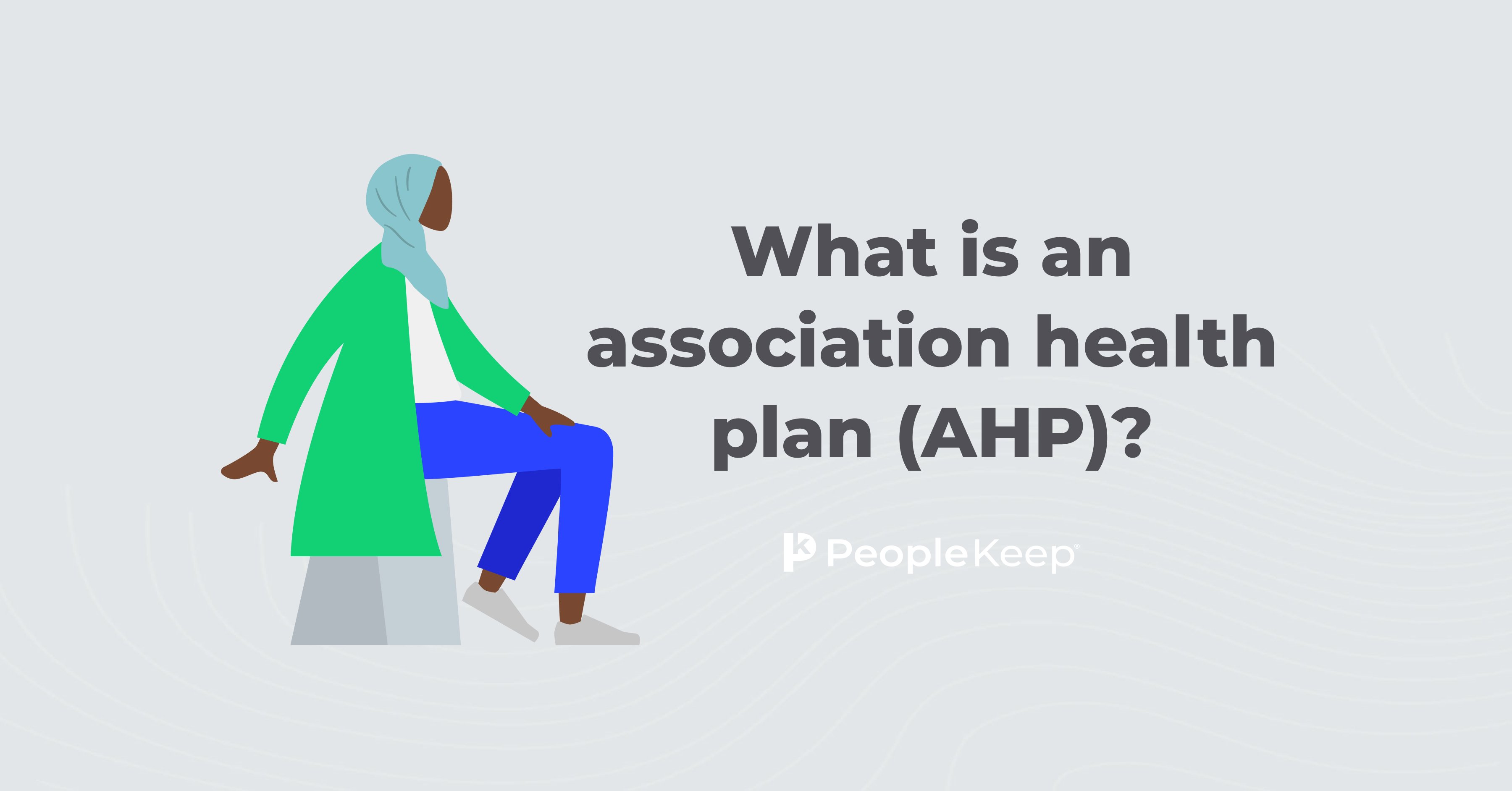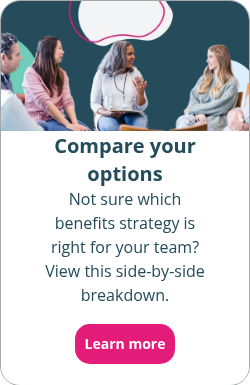Small group health insurance for beginners
By Elizabeth Walker on April 14, 2025 at 11:30 AM
Offering health coverage can be challenging for any business. But it’s especially tough for small employers. In many cases, they have less bargaining power with health insurers, smaller budgets, and often don’t have a dedicated HR professional to manage their benefits packages.
If this sounds familiar, you're not alone. KFF found that the smaller the company, the less likely employees are to receive employer-sponsored health benefits1. Luckily, there are health coverage options out there that are specifically for small employers. One such possibility is small group health insurance. The article below will explain everything you need to know.
In this blog post, you’ll learn:
- What small group health insurance is, what it covers, and who qualifies for it.
- How to enroll in a small business health insurance plan and what it typically costs.
- The alternative options to small group health coverage, such as health reimbursement arrangements (HRAs).
What is small group health insurance?
Small group health insurance is what it sounds like—a medical insurance plan that small employers offer their employees. These policies are only for small businesses. They’re a great way for small employers and startups to attract and retain talented workers to compete with larger companies.
To qualify for a small business health insurance plan, you must:
- Have between two and 50 full-time employees.
- A small group in California, Colorado, New York, or Vermont is any employer with two to 100 workers.
- Pay a portion of your employees' monthly premiums.
- Meet your insurer’s minimum participation requirements.
- Most health insurance companies require at least 50% of your eligible employees to enroll in the policy. But the requirement can be as high as 75%.
What does a small group health insurance policy cover?
There are many types of health insurance plans. But, all small group coverage must meet specific Affordable Care Act (ACA) requirements. Insurers must categorize their plans using the metal tiers of coverage: bronze, silver, gold, and platinum. Policies must also cover the ten essential health benefits.
The essential health benefits are:
- Ambulatory patient services
- Emergency care
- Hospitalization
- Pregnancy, maternity, and newborn care
- Mental health services and substance use disorder services
- Prescription drug coverage
- Rehabilitative and habilitative services and devices
- Laboratory services
- Preventive services, wellness services, and chronic illness management
- Pediatric care
Small group health plans don’t include vision care or dental benefits for adults. If your employees value these services, your insurance carrier may offer “benefit riders” that you can add to your group plan for an extra fee.
You can also add ancillary benefits, such as vision and dental coverage, to your compensation package. These benefits are separate from your small group health insurance coverage, but you can buy them individually from a private exchange.
How do I enroll in a small group health insurance plan?
There are a broad range of ways you can buy a small group health insurance plan:
- Directly from an insurance company
- Through a broker or licensed agent
- From the public Small Business Health Options Program (SHOP) Marketplace if it’s available in your state
If you have fewer than 25 employees, a SHOP plan has a special perk. You may qualify for the small business health care tax credit, which can help reduce your contributions to your employees’ health insurance premiums.
When can I enroll in a small group health insurance plan?
Unlike the individual market, group health insurance plans have no set open enrollment period. That means you can buy a plan whenever you're ready to sign up for one.
Once you choose a plan, your insurance company will generally lock in your premium rate for the entire plan year. You can add or drop employees and dependents anytime within the year. However, your health plan premiums will stay the same.
Once the plan year ends, you can renew your current plan or shop for a new one. With the start of a new plan year comes renewed premium rates, and group health plans almost always rise from year to year—even if you don't make any changes to your plan.
How much does a small group health insurance plan cost?
Like large group plans, small group health insurance requires employers to cover a portion of their employees' health insurance premiums. However, the minimum employer contribution will differ by state and insurer.
If you’re buying SHOP health coverage and want to apply for the tax credit, you must pay at least 50% of an employee's monthly premium. The employee will cover the rest of the cost. While not required, you can also contribute toward the premium costs for an employee's dependents.
Let’s look at the cost in dollars. In 2024, the average annual cost of group health coverage was $8,951 for single policies and $25,572 for family plans. Of those amounts, employers contributed $7,584 toward self-only coverage and $19,276 for family policies2.
But there’s some good news. Thanks to the ACA, the overall health of your employees no longer impacts small group plan rates. So, your insurers can’t raise your health plan premiums if your employees are “high-risk.” This includes if they have a poor health status or pre-existing medical conditions.
Do I have to offer a small group health insurance plan?
The ACA requires applicable large employers (ALEs) with 50 or more full-time equivalent employees (FTEs) to offer affordable health insurance that provides minimum value to at least 95% of their full-time workers and their dependents. If they don’t follow this employer mandate, they may have to pay a fine.
If you have fewer than 50 FTEs, you don't have to offer your employees health insurance. But if you have the budget, you should consider doing so.
Our 2024 Employee Benefits Survey Report found that 92% of employees value health benefits, while only 74% of employers currently offer them. Choosing to provide health insurance benefits can help improve retention, boost morale, and increase job satisfaction.
What are the alternatives to small group plans?
Small group health insurance isn't the only plan option for small employers. In fact, enrollment in these types of plans has been steadily decreasing year over year3. Many small businesses have turned to level-funded or self-insured health plans, which come with extra financial risk. Others have decided to forgo benefits entirely, putting their employees in a tough spot.
But don’t worry; if a small group plan isn’t right for you, you can offer your employees other affordable and flexible health benefits, such as health reimbursement arrangements (HRA) and health stipends.
Health reimbursement arrangements (HRAs)
An HRA is an IRS-approved, employer-funded health benefit that allows you to reimburse your staff tax-free for their qualifying medical expenses, including individual health insurance premiums and out-of-pocket costs.
Instead of dealing with group insurance carriers and annual rate hikes, your employees choose their own individual health plans and medical services. Then, you reimburse them up to a set limit of your choosing after you approve the expense.
Small businesses can use the following two HRAs as an alternative to group health insurance:
- Qualified small employer HRA (QSEHRA)
- A QSEHRA is for companies with fewer than 50 full-time equivalent employees (FTEs). It has no minimum contribution limits, but the IRS does set annual maximum limits. Employers can design their QSEHRA to reimburse employees for premiums only or premiums and out-of-pocket medical expenses. Those participating in the benefit must have a medical plan with minimum essential coverage (MEC).
- Individual coverage HRA (ICHRA)
- The ICHRA is similar to the QSEHRA but has no contribution limits and is for businesses of all sizes. You can set different employee classes to vary eligibility and allowances. Your staff must have a qualified individual health plan to participate, but they can opt in or out of the benefit, depending on affordability.
Health stipends
Small employers can also offer their employees a health stipend. This type of benefit provides employees with a monthly allowance for medical expenses. Employers usually add the stipend to their employees’ paychecks as extra income.
Stipends are flexible in how you can determine payment. For example, you can offer them as a one-time bonus, regularly, or use a reimbursement model, like HRAs. They’re also typically more straightforward for small employers to administer, especially if they have limited time and resources.
Health stipends offer a range of benefits, including the following:
- In addition to full- and part-time workers, 1099 contractors and international employees are eligible to receive stipends.
- Employees who qualify for premium tax credits can collect their stipend and their subsidy at the same time.
- You can offer stipends with other health benefits, including HRAs and small group health insurance.
However, stipends aren’t formal benefits. So, they don't comply with the ACA’s employer mandate if you have at least 50 FTEs. You also can’t require employees to prove they spent their stipend on healthcare services and items. Lastly, stipends are taxable income. This means you must report the stipend amount on your employees' W-2s as extra wages.
Conclusion
Providing your employees with health benefits for the first time is an impressive milestone for any business. But it's not always easy. Exploring and understanding your health insurance options, including traditional group plans and unique reimbursement models, is key to finding the best policy for you and your staff.
If you're ready to offer a personalized health benefit, PeopleKeep by Remodel Health has the solution! Our HRA administration software helps small businesses like yours easily set up and manage customized health benefits, no matter your benefits budget. Book a call with an HRA specialist today to see how HRAs can support your employees.
This blog article was originally published on June 2, 2021. It was last updated on April 14, 2025.
1. Availability of employer-sponsored coverage
2. 2024 Employer Health Benefits Survey
3. Small employers are fleeing from the fully insured market
Check out more resources
See these related articles

What is the Small Business Health Options Program (SHOP) Marketplace?
Learn what the Small Business Options Program (SHOP) Marketplace is and how it provides affordable health insurance options for small businesses.

What are the common healthcare reimbursement models for small businesses?
Learn about the healthcare reimbursement models available for small businesses and find the best fit for your budget and employee needs.

What is an association health plan (AHP)?
An association health plan (AHP) lets small businesses band together to offer coverage. Explore how AHPs work and who qualifies to join one.



